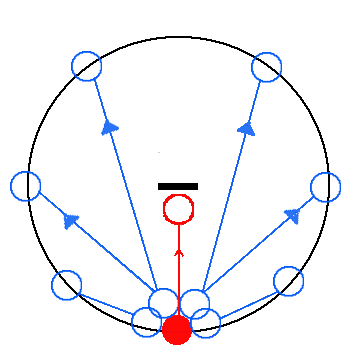
|
Back to |
| The Front Page |
| The Game |
Questions and Answers
by Reuben Edwards |
Our interviews with top international players continue with specific drills you can do to improve your game. They offer advice to players of all skill levels on exercises that will improve your stroke, hoop approaches, rushes, break play, and even get you ready for the often elusive triple peel.
| Q: | What Is Your Favorite Drill? |
IMPROVING YOUR STROKE
 "Something I'll do a lot is shooting at balls. Line up four balls on a boundary line and take four balls into the lawn somewhere and shoot the four balls at the four balls on the boundary. Depending on how many you hit, you either move in, stay where you are, or move out. So if you hit none of them, you go in two yards. If you hit one of them you go in one yard. Hit two of them, you stay where you are. Hit three of them, go out a yard. Hit four of them, you go out two yards. And that sort of gives you an idea of what your critical distance is, which is the point where you hit in fifty percent of your shots. It's useful to know that just to know what your percentage of hitting a particular shot is. And I think it's just a good way of grooving the swing to be able to walk up to a ball and be able to hit it straight.
"
"Something I'll do a lot is shooting at balls. Line up four balls on a boundary line and take four balls into the lawn somewhere and shoot the four balls at the four balls on the boundary. Depending on how many you hit, you either move in, stay where you are, or move out. So if you hit none of them, you go in two yards. If you hit one of them you go in one yard. Hit two of them, you stay where you are. Hit three of them, go out a yard. Hit four of them, you go out two yards. And that sort of gives you an idea of what your critical distance is, which is the point where you hit in fifty percent of your shots. It's useful to know that just to know what your percentage of hitting a particular shot is. And I think it's just a good way of grooving the swing to be able to walk up to a ball and be able to hit it straight.
"
- David Maugham (England)
David suggests shooting at the peg as a variation of this drill. If you hit the peg, move back. If not, move forward. Shooting at the peg from the East and West boundary lines is also a good way to warm up your stroke.
IMPROVING HOOP APPROACHES

|
 "I have an imaginary circle around a hoop. And you have to approach the hoop each time, moving your get-away ball [forward ball] round the circle." "I have an imaginary circle around a hoop. And you have to approach the hoop each time, moving your get-away ball [forward ball] round the circle."
- Debbie Cornelius (England) |
| This is a versatile drill. Try approaching the hoop with the back/striker's ball from various points around the circle. Vary the size of the circle and your choice of shots. Try approaching from various points on a circle one foot around a hoop, then one yard, then two yards. Try approaching using a stop shot, drive, half roll, full roll. Try to get a forward rush after you shoot the hoop. For the more advanced or adventurous players, try peeling the forward ball when the angle permits. | |
IMPROVING RUSHES
 "One of the things, one of the practice drills, if you like, is two-ball breaks. It forces you to learn to approach hoops in a way that makes you get a rush on the other side. Look at top players. I think the thing that differentiates their game from others is that they can very easily reduce the game to basically a combination of easy shots. And I think the way that they do this is by approaching hoops and getting rushes out of hoops. That means good hoop approaches and, as importantly, good hoop control. "
"One of the things, one of the practice drills, if you like, is two-ball breaks. It forces you to learn to approach hoops in a way that makes you get a rush on the other side. Look at top players. I think the thing that differentiates their game from others is that they can very easily reduce the game to basically a combination of easy shots. And I think the way that they do this is by approaching hoops and getting rushes out of hoops. That means good hoop approaches and, as importantly, good hoop control. "
- Aaron Westerby (New Zealand)
Start a two-ball break drill with a perfect rush to hoop #1 from corner #1. If you're intimidated by even the thought of doing a two-ball break, try it on half sized court first. Or work on mastering three-ball breaks. Start with two balls on the boundary in corner #1 and a ball by hoop #1. Rush a ball onto the lawn, then begin your break. For another excellent but challenging rush drill, see Q&A #1.
PRACTICING THREE-BALL BREAKS
"Start it with, perhaps, a different corner cannon each time. That's a good one. You get lot's of split shots. You try and get forward rushes after a hoop."- John Prince (New Zealand)
A three-ball break drill can also start with two balls in corner #1 and a ball at hoop #1. Rush the corner ball out, then send it to hoop #2. For American Rules players, try setting various leaves and play the break from there. Put one ball at hoop #2 and two balls on the West boundary with a rush toward corner #2. Rush the forward ball out and run the break. There is more information on running breaks on the Oxford Croquet Page.
PRACTICING TRIPLE PEELS
"People often ask me, 'When should I start trying triple peels?' And I say, if you can make three complete [consecutive] three ball breaks, then you're certainly ready to start triple peeling."- John Prince (New Zealand)
Learning to peel will help your game no matter which game you play - American Rules or International Rules. For International Rules, the triple peel is a must at high level play. In American Rules, although the triple peel isn't a standard part of the game, practicing the skills involved in triple peeling will get you and keep you at the highest level of play. There is more information on the triple peel on the Oxford Croquet Page.
For more practice drills - especially for the American Rules Game - see Nate's Notes.